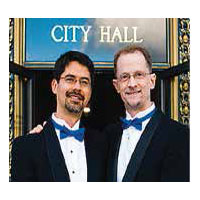
By John Lewis–
On an early September evening several months ago, I opened my eyes from meditation and gazed out our back window at a hauntingly beautiful half-moon, glowing orange in the night sky. As the moon’s sumptuous color captivated me, I also realized it meant that the atmosphere that night was particularly filled with smoke from the wildfires that had been burning for weeks across Northern California.
When I awakened the next morning and glanced at my clock, I was surprised to see that I had slept well into the morning. When I glanced bleary-eyed out the back window, things got stranger. I saw not only that the cars still had their headlights on, but also a shimmering pink orb now hung against a blue grey sky exactly where the luminous half-moon had been the night before. I immediately wondered: How in the world did the moon grow from half to full overnight? And, for that matter, how could it be rising again just 12 hours later?

Before going to sleep the night before, I had been reading Haruki Murakami’s dystopian masterpiece 1Q84, in which Murakami reimagines the George Orwell classic, setting it in 1984 Japan. In the book, the main characters see not one but two moons in the sky as they step out of the ordinary way of experiencing the world into a psychologically and spiritually dystopian one.
Were there now two moons over San Francisco? Were we now living in the year 202Q?
A couple hours later, Stuart and I ventured out for a short walk up to McLaren Park. A nearby meadow shone a luminescent green. Redwoods and cypress stood silhouetted against the now orange-grey sky. An eerie stillness and silence pervaded, punctuated only by a few birds chirping. On our way home in the muted darkness, we saw our neighbors’ faces illuminated by the light of their computer screens through their windows as they worked busily on a workday. We would soon return ourselves to the separateness of our own computers and go through the motions of our regular daily routines, even though the day was anything but normal.
Now at years end, the altered reality of that September day seems like a metaphor for all of 2020 or 202Q.
In March, we awakened to another other-worldly experience—an order to “shelter in place,” a term prior to that I had associated with an urgent need to protect oneself when an active shooter was in the immediate surroundings. Looking out our same back window last March, nothing seemed different; yet a global pandemic with potentially catastrophic consequences had begun. Assessing how long one’s toilet paper (and hand sanitizer) supply would last, and strategizing how to get more—things that would have seemed crazy just days before—suddenly seemed reasonable. For those of us who lived through the worst of the HIV/AIDS pandemic, overnight feelings of vulnerability and fear of loss were disturbingly familiar.
In July, we encountered something else previously unimaginable: experiencing from our living room the death of Stuart’s dad in a hospital ICU via Zoom. It felt oddly intimate, in some ways creating the ultimately false impression that we were there in person. But we were present in a different way. We simultaneously felt both deeply connected and separate. And after such an experience, do you just go back to work in your living room? The other loved ones we wanted to hug, something not even safe to do in the pandemic, were many miles away.
Meanwhile, Donald Trump created a reality-denying belief in his followers that there was nothing to worry about. He declared that 99% of COVID-19 cases were “totally harmless” and that the pandemic would soon “disappear … like a miracle.” Last month, an incredulous Wisconsin physician reported that one of her patients refused to believe COVID-19 was a serious concern even as the disease killed her. And, according to a recent poll, some 88 percent of Trump’s supporters live in the delusion that the 2020 election was stolen from him.
At the same time, the murders of George Floyd, Breonna Taylor, and Ahmaud Arbery exposed the reality of racism in 202Q America, making it even more difficult for people to look the other way. These horrific killings laid bare not only racial bias in law enforcement and the judicial system, but also how differently and separately many Americans of different races and classes live. Persistent segregation and income inequality give rise to very different perceptions of the world to the detriment of those who are disadvantaged. Far too many Americans look up at the same moon in the night sky from very different perspectives.
During the height of the September wildfires, a Mendocino resident reported that his roosters crowed all day long. Were they trying to alert us to wake up?
In 1Q84, a random taxi driver cautioned the protagonist that “there’s always only one reality.” Even as we contend with competing perceptions of reality, many of which are patently false and cause great suffering, we retain a great deal of control over how we perceive the world and whether we live with intention and integrity. Compassion, connection, and capacity for circumspection are all real.
As we transition from 2020 to 2021, will we personally and as a society make the coming year another 202Q or something different? The choice is ours.
Stuart Gaffney and John Lewis, together for over three decades, were plaintiffs in the California case for equal marriage rights decided by the California Supreme Court in 2008. Their leadership in the grassroots organization Marriage Equality USA contributed in 2015 to making same-sex marriage legal nationwide.
Published on December 17, 2020
Recent Comments